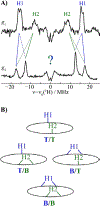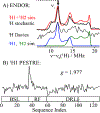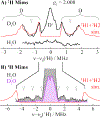High-Resolution ENDOR Spectroscopy Combined with Quantum Chemical Calculations Reveals the Structure of Nitrogenase Janus Intermediate E4(4H)
- PMID: 31310109
- PMCID: PMC6956989
- DOI: 10.1021/jacs.9b04474
High-Resolution ENDOR Spectroscopy Combined with Quantum Chemical Calculations Reveals the Structure of Nitrogenase Janus Intermediate E4(4H)
Erratum in
-
Correction to "High-Resolution ENDOR Spectroscopy Combined with Quantum Chemical Calculations Reveals the Structure of Nitrogenase Janus Intermediate E4(4H)".J Am Chem Soc. 2019 Dec 18;141(50):19950. doi: 10.1021/jacs.9b13035. Epub 2019 Dec 10. J Am Chem Soc. 2019. PMID: 31820971 No abstract available.
Abstract
We have shown that the key state in N2 reduction to two NH3 molecules by the enzyme nitrogenase is E4(4H), the "Janus" intermediate, which has accumulated four [e-/H+] and is poised to undergo reductive elimination of H2 coupled to N2 binding and activation. Initial 1H and 95Mo ENDOR studies of freeze-trapped E4(4H) revealed that the catalytic multimetallic cluster (FeMo-co) binds two Fe-bridging hydrides, [Fe-H-Fe]. However, the analysis failed to provide a satisfactory picture of the relative spatial relationships of the two [Fe-H-Fe]. Our recent density functional theory (DFT) study yielded a lowest-energy form, denoted as E4(4H)(a), with two parallel Fe-H-Fe planes bridging pairs of "anchor" Fe on the Fe2,3,6,7 face of FeMo-co. However, the relative energies of structures E4(4H)(b), with one bridging and one terminal hydride, and E4(4H)(c), with one pair of anchor Fe supporting two bridging hydrides, were not beyond the uncertainties in the calculation. Moreover, a structure of V-dependent nitrogenase resulted in a proposed structure analogous to E4(4H)(c), and additional structures have been proposed in the DFT studies of others. To resolve the nature of hydride binding to the Janus intermediate, we performed exhaustive, high-resolution CW-stochastic 1H-ENDOR experiments using improved instrumentation, Mims 2H ENDOR, and a recently developed pulsed-ENDOR protocol ("PESTRE") to obtain absolute hyperfine interaction signs. These measurements are coupled to DFT structural models through an analytical point-dipole Hamiltonian for the hydride electron-nuclear dipolar coupling to its "anchoring" Fe ions, an approach that overcomes limitations inherent in both experimental interpretation and computational accuracy. The result is the freeze-trapped, lowest-energy Janus intermediate structure, E4(4H)(a).
Figures
















Similar articles
-
Reductive Elimination of H2 Activates Nitrogenase to Reduce the N≡N Triple Bond: Characterization of the E4(4H) Janus Intermediate in Wild-Type Enzyme.J Am Chem Soc. 2016 Aug 24;138(33):10674-83. doi: 10.1021/jacs.6b06362. Epub 2016 Aug 16. J Am Chem Soc. 2016. PMID: 27529724 Free PMC article.
-
Electron Redistribution within the Nitrogenase Active Site FeMo-Cofactor During Reductive Elimination of H2 to Achieve N≡N Triple-Bond Activation.J Am Chem Soc. 2020 Dec 30;142(52):21679-21690. doi: 10.1021/jacs.0c07914. Epub 2020 Dec 16. J Am Chem Soc. 2020. PMID: 33326225 Free PMC article.
-
Reversible Photoinduced Reductive Elimination of H2 from the Nitrogenase Dihydride State, the E(4)(4H) Janus Intermediate.J Am Chem Soc. 2016 Feb 3;138(4):1320-7. doi: 10.1021/jacs.5b11650. Epub 2016 Jan 20. J Am Chem Soc. 2016. PMID: 26788586 Free PMC article.
-
Computational Investigations of the Chemical Mechanism of the Enzyme Nitrogenase.Chembiochem. 2020 Jun 15;21(12):1671-1709. doi: 10.1002/cbic.201900636. Epub 2020 Jan 21. Chembiochem. 2020. PMID: 31803989 Review.
-
Nitrogenase Bioelectrochemistry for Synthesis Applications.Acc Chem Res. 2019 Dec 17;52(12):3351-3360. doi: 10.1021/acs.accounts.9b00494. Epub 2019 Dec 4. Acc Chem Res. 2019. PMID: 31800207 Review.
Cited by
-
Protonation of Homocitrate and the E1 State of Fe-Nitrogenase Studied by QM/MM Calculations.Inorg Chem. 2023 Dec 4;62(48):19433-19445. doi: 10.1021/acs.inorgchem.3c02329. Epub 2023 Nov 21. Inorg Chem. 2023. PMID: 37987624 Free PMC article.
-
A model for dinitrogen binding in the E4 state of nitrogenase.Chem Sci. 2019 Oct 15;10(48):11110-11124. doi: 10.1039/c9sc03610e. eCollection 2019 Dec 28. Chem Sci. 2019. PMID: 32206260 Free PMC article.
-
Understanding the Electronic Structure Basis for N2 Binding to FeMoco: A Systematic Quantum Mechanics/Molecular Mechanics Investigation.Inorg Chem. 2023 Apr 10;62(14):5357-5375. doi: 10.1021/acs.inorgchem.2c03967. Epub 2023 Mar 29. Inorg Chem. 2023. PMID: 36988551 Free PMC article.
-
Biological nitrogen fixation in theory, practice, and reality: a perspective on the molybdenum nitrogenase system.FEBS Lett. 2023 Jan;597(1):45-58. doi: 10.1002/1873-3468.14534. Epub 2022 Nov 28. FEBS Lett. 2023. PMID: 36344435 Free PMC article. Review.
-
Analysis of the Geometric and Electronic Structure of Spin-Coupled Iron-Sulfur Dimers with Broken-Symmetry DFT: Implications for FeMoco.J Chem Theory Comput. 2022 Mar 8;18(3):1437-1457. doi: 10.1021/acs.jctc.1c00753. Epub 2022 Feb 15. J Chem Theory Comput. 2022. PMID: 35167749 Free PMC article.
References
-
- Burgess BK; Lowe DJ Mechanism of Molybdenum Nitrogenase. Chem Rev 1996, 96, 2983–3012. - PubMed
-
- Thorneley RNF; Lowe DJ Kinetics and Mechanism of the Nitrogenase Enzyme System. Metal Ions in Biology 1985, 7, 221–284.
-
- Wilson PE; Nyborg AC; Watt GD Duplication and Extension of the Thorneley and Lowe Kinetic Model for Klebsiella Pneumoniae Nitrogenase Catalysis Using a Mathematica Software Platform. Biophysical Chemistry 2001, 91, 281–304. - PubMed
Publication types
MeSH terms
Substances
Grants and funding
LinkOut - more resources
Full Text Sources

